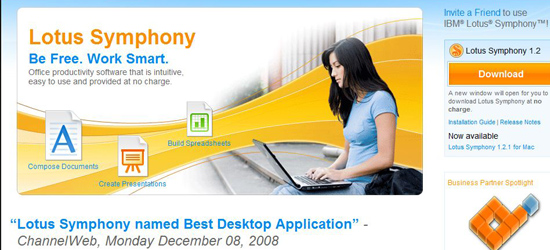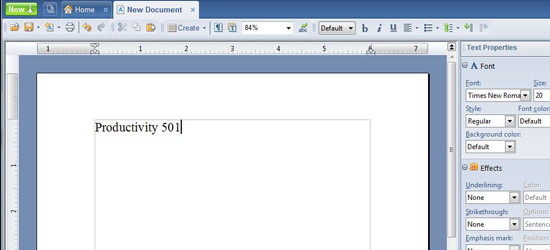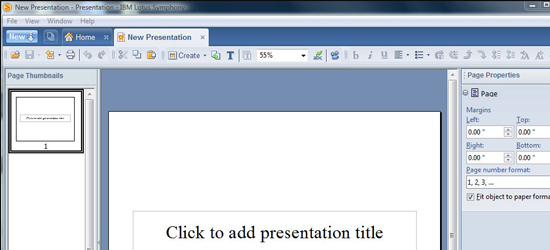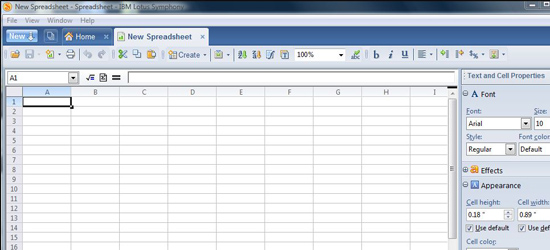Most people have heard the expression, “There is no free lunch.” While this may be true in some situations, it isn’t always true in the realm of application software. Desktop publishing is one area where there are not a whole lot of alternatives. Microsoft hold the biggest share of the market, by far. However, IBM has come up with a free product called Symphony, which includes capabilities similar to a Microsoft Office Suite. Although the two programs are similar, they are, by no means, mirror images of each other.
First Impressions
Though the Microsoft Office Suite has just undergone a major update, some find the new layout a bit more confusing than they did the old. The word processor on Symphony shares more attributes with the 1997-2003 version of Word than the 2007 revision. For some, this may make things easier to find and use. For example, creating tables with Symphony is a very similar process to that in Word, although perhaps a bit simpler. The main difference is the developer’s use of icons for easy location of features. Instead of going to a “tools” tab and into a long line of drop-down menus, IBM simply has placed a single icon for user convenience.
Installation process
The attribute that most users will find attractive about Lotus Symphony is that it is free. While it does take some time to download, the product runs smoothly and efficiently enough to be considered an effective productivity tool by most, I would think. Though Symphony is free, IBM does require registry of the product. In addition, the download process isn’t quite as streamlined as I expected, but it gets the job done. One thing that a prospective downloader might watch for is the check box marks on the agreement page. The site doesn’t prevent the download from taking place if a check box is accidentally not marked. Therefore, the user can go through most of the installation process only to get a “missing file” error message, which then triggers the installation process to undo everything it has accomplished up to that point. Once all of the boxes are checked and the agreements marked, the program installs completely without any problems.
Benefits
Symphony has many of the same capabilities and attributes of its well-known competitors. One thing that I really liked about Lotus that I’ll reiterate is that the developers used more icons for common processes instead of burying them in odd places under a drop-down menu. With some desktop publishing programs I have used, half the battle is won if user can simply find where the tool is located. The developers behind Lotus seem to have taken this in mind when designing the user interface for their programs. Also, Symphony is available for users running Linux, Windows XP or Vista, and also Mac OSX. Lotus’ versatility is one time saver for those using computers with diverse operating systems.
Drawbacks
The drawbacks of Lotus are few, as far as I have seen. It runs smoothly, has a pleasing layout and seems to be a worthy competitor for the business world. However, one thing that a user might want to take into account is that the software, especially the presentation side of things, seems to be geared more toward business presentations, which is wonderful if this is what it is going to be used for. For those looking for a more creative than businesslike version of presentation software, this might not be the right product; however, it is perfectly suited to the needs of a businessperson with its simple integration for charts and other graphics.
Conclusion
All in all, the Symphony lineup of Document, Spreadsheet and Presentation creation software seem to fit the audience they were intended for very well. Each aspect of the program functions much like the Microsoft versions of each comparable program. While there is some free software available now that is not coducive to a productive lifestyle, Lotus Symphony seems to be quite the opposite.




Thanks for your great review and pointers on the downloading process. I will get someone to look into it.
– Bilal Jaffery
IBM Web Marketing Manager
Bilal – A big thank you to IBM for making such great software available!
How is that there is no mention to OpenOffice? It has been around for a long time, completely free and for me it is without any doubt as good as MS Office. In fact, I bet it has been downloaded much more than Simphony.
By the way, desktop publishing is a completely different thing
http://en.wikipedia.org/wiki/Desktop_publishing
@Carlos – We aren’t trying to slight OO, but Symphony is a new product that most people who have heard of Open Office probably haven’t heard of. Good suggestion though. We should probably do a review of it in the near future.
I haven’t used OO because their OS X support was a bit clunky. I think that may have changed and I need to give it a shot again.
Lotus Symphony is built upon Open Office/Star Office. Another minor issue is that after installation you might begin receiving an error that “soffice.exe failed to start, unable to locate component warning.” This is a Star Office component. Resolution is remove and reinstall Lotus Symphony.